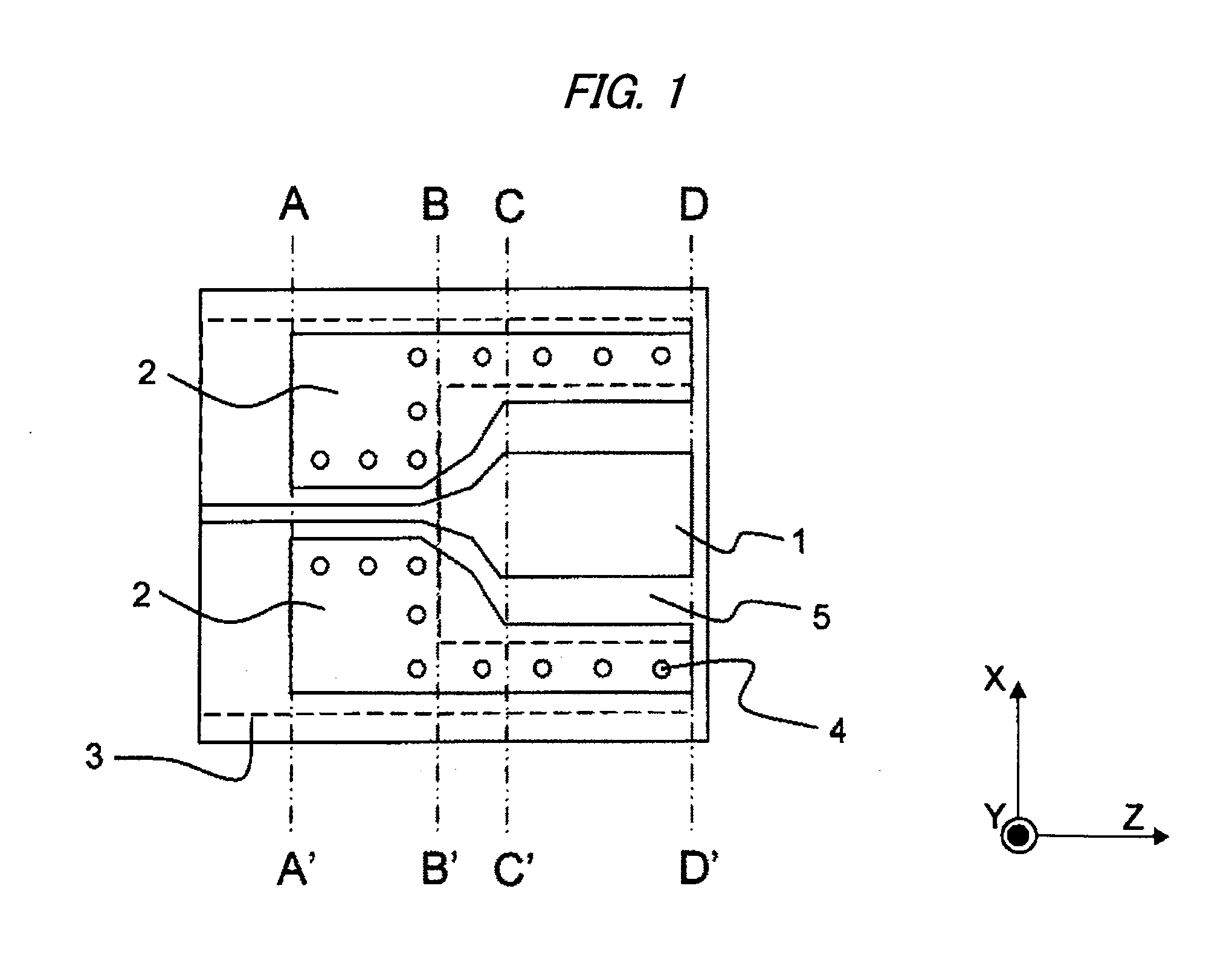Optical module
a technology of optical modules and optical modules, applied in the field of optical modules, can solve the problems of deterioration of transmission characteristics, easy reduction of transmission characteristics, and change of characteristic impedance, and achieve the effects of excellent transmission characteristics, easy acquisition of optical modules, and easy deterioration of high-frequency signals
- Summary
- Abstract
- Description
- Claims
- Application Information
AI Technical Summary
Benefits of technology
Problems solved by technology
Method used
Image
Examples
first embodiment
[0051]FIG. 1 is a top view showing a configuration of a flexible substrate of a first embodiment. FIG. 2A to FIG. 2D illustrate a cross-sectional view of the left side of A-A′ of FIG. 1, a cross-sectional view of the part between A-A′ and B-B′, a cross-sectional view of the part between B-B′ and C-C′, and a cross-sectional view of the part between C-C′ and D-D′, respectively.
[0052]In FIG. 1 and later-described FIGS. 3-5, 6, 8, 10 and 13, wiring patterns formed on a surface (upper surface) side of a base film 5 are illustrated by solid lines, and wiring patterns formed on a back surface side are illustrated by dotted lines. Hereinafter, these electrode layout patterns will be described.
[0053]As is understood from FIG. 2A to FIG. 2D, a signal line 1 to which signals representing information to be transmitted are applied and surface ground lines 2 to which a ground potential is applied are patterned on the surface side of the base film 5, and a back-surface ground line 3 to which the g...
second embodiment
[0072]FIG. 3 is a top view illustrating a configuration of a flexible substrate of a second embodiment of the present invention, and FIG. 4 is a top view illustrating a configuration of a modification example of the flexible substrate of the second embodiment of the present invention.
[0073]FIG. 3 and FIG. 1 have two different points. The first different point is that a signal pad 6 connected by the contact holes 4 are patterned on the back surface that is overlapped with the signal line 1 in the coplanar line. A lead pin can be fixedly attached by the signal pad 6 from the back-surface side of the flexible substrate.
[0074]A width L3 of the signal pad 6 is narrower than a width L4 of the coplanar line of the signal line 1. In other words, the signal line 1 of the surface side is closer to the ground lines 2 than the signal pad 6 of the back-surface side is. Thus, there are advantages that the influence exerted on the characteristic impedance by the signal pad 6, which is patterned on...
third embodiment
[0077]FIG. 5 is a top view showing a configuration of a flexible substrate of a third embodiment of the present invention.
[0078]A point largely changed from FIG. 1 is that the back-surface ground line 3 is not provided in the coplanar line. The characteristic impedance of this part is maintained substantially only by the distances between the signal line 1 and the surface ground lines 2. This case has an advantage that a variation in the characteristic impedance due to the surface / back surface pattern positional misalignment in the X-axis direction is almost completely eliminated even when the positional misalignment of the surface / back surface patterns of the flexible substrate is particularly large.
PUM
 Login to View More
Login to View More Abstract
Description
Claims
Application Information
 Login to View More
Login to View More - R&D
- Intellectual Property
- Life Sciences
- Materials
- Tech Scout
- Unparalleled Data Quality
- Higher Quality Content
- 60% Fewer Hallucinations
Browse by: Latest US Patents, China's latest patents, Technical Efficacy Thesaurus, Application Domain, Technology Topic, Popular Technical Reports.
© 2025 PatSnap. All rights reserved.Legal|Privacy policy|Modern Slavery Act Transparency Statement|Sitemap|About US| Contact US: help@patsnap.com



